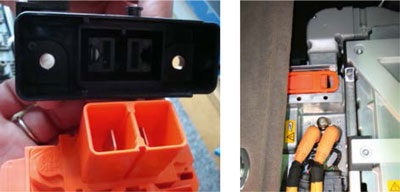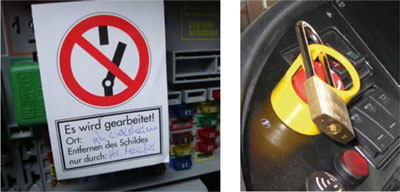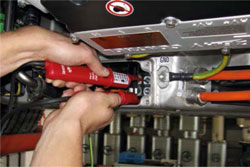Abschnitt 3.1 - III. Electrical hazards presented by high voltage on vehicles
1. Electrical work on the HV systems of vehicles
Electrical work may not be started until protective measures have been taken against electric shock, short-circuits and fault arcs. More detailed information on the hazards presented by electric current can be found in informative publication BGI 548 (in german) governing skilled electrical persons.
Work may not generally be performed on live parts of electrical systems and equipment. For this purpose, these systems and equipment must be placed in the non-live state prior to and for the duration of the work.
This is achieved by the observance of five safety rules.
 Five safety rules Five safety rulesPrior to starting work
|
|---|
These five rules for safe work are vital. The rules must generally be observed in the order stated.
The five safety rules are generic for all electric power systems, irrespective of the actual voltage level. Certain lower constraints may apply to systems with rated voltages of up to 1.000 V. The first three rules must be applied during work on the HV system. Whether the fourth and fifth rules must also be applied must be determined on a case-by-case basis.
In a given case, the requirement for application of the five safety rules on vehicles with HV systems can for example be met as follows (as determined by the manufacturer concerned):
Rule 1: Isolate
Switch off the ignition,
Withdraw service plug/switch off main battery switch,
Remove fuses,
Withdraw plug for interlock/pilot/monitoring circuit,
Disconnect from the stationary grid (e. g. charging plug).

Service plug
Rule 2: Safeguard against reconnection
Remove the ignition key and prevent unauthorized access to it,
Store the service plug against unauthorized access/safeguard the main battery switch against reconnection, for example by means of a lock or lockable shroud,
Observe further internal company provisions and the manufacturer's information.

Examples of safeguarding against reconnection
Rule 3: Verify the non-live state
Residual charges (for example voltages in intermediate circuits) may be present even when the HV voltage has been disconnected.

Verification of the non-live state
 The non-live state of the HV system must therefore always be verified before work is begun! The non-live state of the HV system must therefore always be verified before work is begun!
|
|---|
In accordance with German accident prevention regulation BGV/GUV-V A3, "Electrical installations and equipment", the non-live state may be verified only by a skilled electrical person or a person who has received electrical instruction. The provisions of the vehicle manufacturer must be observed for verification of the non-live state.
Suitable voltage testers ortest apparatus specific to the manufacturer must be used. Test apparatus is suitable in particular when it has been tested against the necessary criteria by a test body and found to be suitable. Multimeters have led to a high rate of accidents on high-energy parts of apparatus; they are not therefore suitable.
Other mobile instruments are suitable for verifying the non-live state when they also satisfy the provisions for voltage detectors to DIN VDE 0682-401 Part 3, "Voltage detectors: Two-pole low-voltage type". Where standard commercial voltage testers are used, ensure that they are suitable for the type and level of the voltage to be measured and that they are fully serviceable. Their full serviceability must be determined before verification of the non-live state. The non-live state must be verified on all conductive parts which could be live. Until the non-live state has been verified, the system is to be assumed to be live.
Completion of the work
Once the work has been completed, the safety rules are lifted again. All tools, auxiliary material and other equipment must first be removed from the site of the work and the hazard area. Guards removed before the start of work must be properly replaced and warning signs removed.
